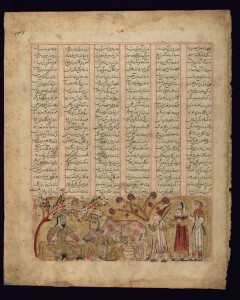The Art of the Book
The Islamic world created illuminated manuscripts that rivaled anything that came out of a medieval monastery: Qu’rans, historical chronicles, stories of the prophets, the deeds of kings, lyric poetry, heroic epics, philosophy, scientific treatises, and romantic tales.
Caliphs, courtiers, and wealthy merchants commissioned manuscripts from the ninth century until well into the seventeenth century, when the Islamic world reluctantly accepted the value of Mr. Gutenberg’s printing press. Each manuscript was an expensive and unique production that required the talents of many artists: craftsman who ruled the pages, calligraphers, painters, illuminators, bookbinders and chest makers.
Each page was designed with a ruled frame that determined the number of lines of text on the page and the size and location of paintings, chapter headings, texts and borders. The modern viewer focuses on the miniatures, wonderfully detailed paintings often no larger than a sheet of notebook paper. For the original audience, the paintings are second to the quality of the calligraphy. As sixteenth Iranian author Qadi Ahmad put it, “If someone, whether he can read or not, sees good writing, he likes to enjoy the sight of it.” Calligraphers were not anonymous copyists, but revered artists who learned at the hand of a master.
Unlike books in English, where there are many fonts but only one script, Islamic calligraphers had many scripts to chose from, each with a different graphic and emotional quality. They could be slanted or rounded, upright or “hanging”, angular or cursive. Some were designed to be easily read, others to be decorative. Qu’rans were often written in one of the angular kufic scripts. One script was described as the “bride of calligraphic styles” and was generally used for lyric poetry and romantic tales.
You’ve got to wonder what the producers of these works would think about the modern paperback.
This post previously appeared at Wonders and Marvels.






[…] first, I found the factoid charming: a lovely illustration of the importance of books in the early Islamic world. Then I felt a little jealous at the idea of owning 1117,000 books. Now I just feel inadequate […]